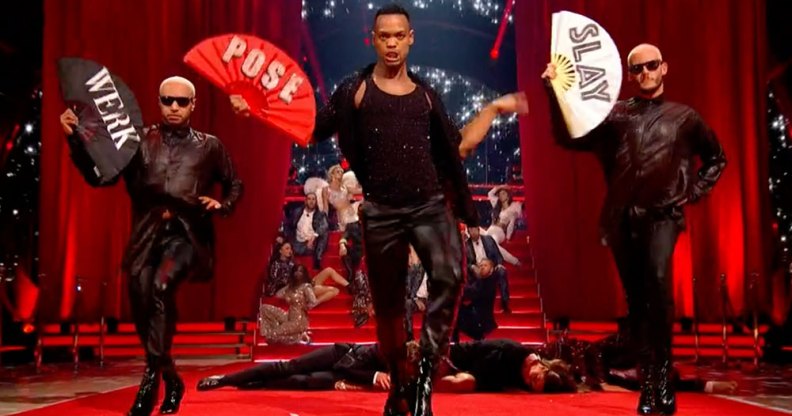Journalist absurdly claims ‘gays and ethnic minorities’ are ‘over-represented’ on TV and the backlash is fierce

Johannes Radebe performed a voguing routine in high heels during the 2018 series. (BBC)
Johannes Radebe performed a voguing routine in high heels during the 2018 series. (BBC)
The bar has been raised when it comes to diversity, a study has claimed, where more “gays and ethnic minorities” are gracing television and laptop screens in Britain.
Discrimination is over! We won! Even if hate crime in England and Wales has more than doubled in the last four years!
In a report by Creative Diversity Network, the group surveyed “more than 30,000 diversity forms relating to over 600,000 TV production contributions” across the five major broadcasters: BBC, ITV, Channel Four, Channel Five and Sky.
The Diamond: The Third Cut enquiry found that LGB folk make up around 11.9 per cent of roles. One in 10 characters are LGB, the paper said, and around 6.4 per cent of the national population identify as such.
Trans folk, the paper continued, make up 0.8 per cent of on-screen roles and 0.2 per cent of off-screen TV positions.
This demonstrates, British newspaper The Times said, that LGB people are “twice as likely to appear on television” and are, in fact, “over-represented”.
Although, the statistics mean that 88.1 per cent of roles go to heterosexual people who are, not in the slightest bit, “over-represented”.
It was a finding, however, vastly distorted by some. One British lawmaker joined the discussion of the findings and made similar claims of “over-representation” of queer folk in the media.
“But, but… TV is so racist & homophobic…”
Turns out it isn’t. In fact it’s the precise opposite:
* BAME = 13% workforce v 26% drama roles, 30% kids TV, 25% comedies
* LGBT = 6.4% population v 11.9% rolesSo they are twice as likely to be cast versus population 🤷🏼♂️ pic.twitter.com/cUOAxHgNGA
— Martin Daubney 🇬🇧 (@MartinDaubney) February 27, 2020
As a result, the framing of the study by certain people induced mass eye-rolls from members of the LGBT+ community.
What did the study say?
The study shows, according to Brexit Party member Martin Daubney, that British TV shows “over-represent” people of diverse sexualities and ethnicities.
Right.
Daubney explained that the number of minority characters is around double than that of national demographics.
“Add to this that women are also over-represented in both on-screen and off-screen,” he added. “So TV isn’t sexist either.
“Statistically, the worst career prospects in TV are for white, heterosexual men.
Naturally I’m expecting “poor white men who run the world” etc. But the stats don’t lie. TV doesn’t represent the real world, which you may argue is “PC madness” or “well, about time”— Martin Daubney 🇬🇧 (@MartinDaubney) February 27, 2020
“Turns out the ‘white male privilege’ we hear so much about on TV… doesn’t exist in TV.”
Black and ethnic minority actors make up a slim 23 per cent of on-screen roles, according to the statistics. Meaning that 77 per cent of roles go to white folk.
BAME folk find more roles in drama (26 per cent) and children’s TV shows (30 per cent).
While people aged over-50 are the most “under-represented”, Daubney said, because they account for 31 per cent of the workforce yet their measly contribution to television is just 20.6 per cent.
Which is double that of LGB characters.
The report also found that off-screen positions in British TV is vastly mired by a lack of diversity, especially in senior positions.
BAME directors, screenwriters and series producers are vastly under-represented. “There is more work to do,” Jill Offman, Creative Diversity Network chair, wrote in the report.
Representation of disabled people in TV has ‘flatlined’, says diversity campaigner.
Deborah Williams, executive director of the Creative Diversity Network, described to The Times how the representation of disabled folk had, in recent years, “flatlined”.
Disabled people consist of 7.8 per cent of on-screen jobs and 5.2 per cent of off-screen, the data, which covers programmes broadcast from August 2018 to July 2019, said. Disabled folk make up 17 per cent of the population.
She also skewered studios for treating the representation of BAME people as a “quick win”.
“So much time is spent on quick wins, that digging deeper hasn’t necessarily been a priority,” she said. “The easiest thing to do, and everyone is guilty of this whether in television or other industries, is to find a black person and put them on.”
Daubeny later added in the Twitter thread: “The real discrimination in TV isn’t race, sexuality or gender. It’s class. Where are the working-class heroes?
“Answer: they get the worst qualifications. They need to survive. Drama school? Journalism course?
“It’s a luxury they could only ever dream of.”
‘Representation isn’t about raw numbers, it’s about normalising traditionally marginalised groups.’
However, a number of LGBT+ people lampooned Daubney’s take on the data. Some argued the difference between reflecting a nation’s demographics and how diversifying TV programming can be impactful for groups marginalised off-screen.
https://twitter.com/JackDunc1/status/1232987548148019201
Super weird, Martin. It’s almost like marginalized people get so much hate in everyday life that we’re written into shows in which that hate is highlighted for ratings.
Come back to me when, for example, trans characters don’t exist primarily to showcase their trauma.— Amanda Jetté Knox (@MavenOfMayhem) February 27, 2020
A lot of BAME and LGBT people get into creative industries after years of oppression and bullying as kids – striving to prove their critics wrong and to change the norm. Homophobic hate crimes are up in London by 55% in the last 5 years. For BAME, it's up 11% in the last year. https://t.co/rl6Qh44LtJ— Pádraig Prendergast (@prendergast) February 27, 2020
If BAME people account for 23% of on-screen roles and LGB people account for 11.9% of on-screen roles, that means 77% of roles still go to white people and 88.1% of roles still go to straight people. Get over yourself. https://t.co/ouDzlA2vuZ
— O (@sleepyseas) February 27, 2020

